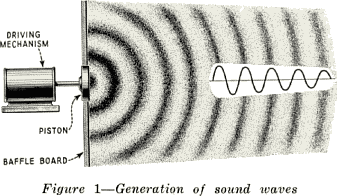1. Definition of Sound.- There
are various definitions of sound. Therefore at the start it is well to have an
understanding as to the definition of the word as used in this and in the
succeeding chapters of this book.
Sound can be considered as a series of vibrations of the air of such frequency, or
pitch, that it is audible to the human ear.

Sound is sometimes defined as an audio
sensation in the ear. Such a definition requires a person to be located in the vibrating
air before sound can exist, and is therefore inconvenient in a discussion of
sound reproduction.
(A) PRODUCTION OF SOUND
2. Production of Sound.- Sound is
produced when air is set into vibration by any means whatsoever, provided that
the frequency of vibration is such that it is audible, but sound is usually
produced by some vibrating object which is in contact with the air. If we take
a string, such as used on a banjo or similar instrument, stretch it taut
between two fairly solid supports a few feet apart and pluck it, sound is
produced which dies down in a fairly short time. When the string is plucked it
springs back into position, but, due to its weight and speed, it goes beyond
its normal position, oscillates back and forth through its normal position, and
gradually comes to rest. As the string moves forward it pushes air before it
and compresses it, also air rushes in to fill the space left behind the moving
string. In this way the air is set into vibration. Since air is an elastic
medium, the disturbed portion transmits its motion to the surrounding air so
that the disturbance is propagated in all directions from the source of
disturbance.
If the string is connected in some way
to a diaphragm such as the stretched drum-head of a banjo, the motion is
transmitted to the drum. The drum, having a large area exposed to the air, sets
a greater volume of air in motion, and a much louder sound is produced.
1

